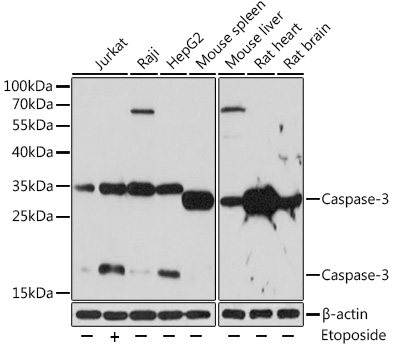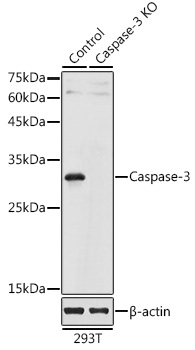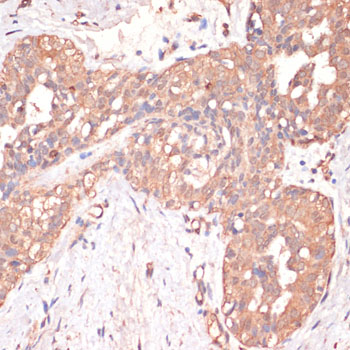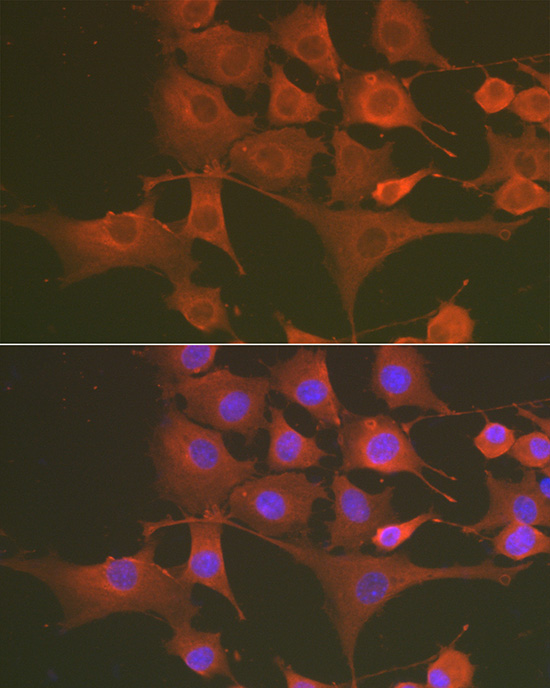Product Name :
[KO Validated] Caspase-3 polyclonal antibody Background :
This gene encodes a protein which is a member of the cysteine-aspartic acid protease (caspase) family. Sequential activation of caspases plays a central role in the execution-phase of cell apoptosis. Caspases exist as inactive proenzymes which undergo proteolytic processing at conserved aspartic residues to produce two subunits, large and small, that dimerize to form the active enzyme. This protein cleaves and activates caspases 6, 7 and 9, and the protein itself is processed by caspases 8, 9 and 10. It is the predominant caspase involved in the cleavage of amyloid-beta 4A precursor protein, which is associated with neuronal death in Alzheimer's disease. Alternative splicing of this gene results in two transcript variants that encode the same protein. Product :
1mg/ml in PBS with 0.02% sodium azide, 50% glycerol, pH7.2 Storage&Stability :
Store at 4°C short term. Aliquot and store at -20°C long term. Avoid freeze-thaw cycles. Specificity :
Polyclonal Antibodies Immunogen :
Recombinant fusion protein of human Caspase-3(NP_004337.2). Conjugate :
Unconjugated Modification :
Unmodification
[KO Validated] Caspase-3 polyclonal antibody Background :
This gene encodes a protein which is a member of the cysteine-aspartic acid protease (caspase) family. Sequential activation of caspases plays a central role in the execution-phase of cell apoptosis. Caspases exist as inactive proenzymes which undergo proteolytic processing at conserved aspartic residues to produce two subunits, large and small, that dimerize to form the active enzyme. This protein cleaves and activates caspases 6, 7 and 9, and the protein itself is processed by caspases 8, 9 and 10. It is the predominant caspase involved in the cleavage of amyloid-beta 4A precursor protein, which is associated with neuronal death in Alzheimer's disease. Alternative splicing of this gene results in two transcript variants that encode the same protein. Product :
1mg/ml in PBS with 0.02% sodium azide, 50% glycerol, pH7.2 Storage&Stability :
Store at 4°C short term. Aliquot and store at -20°C long term. Avoid freeze-thaw cycles. Specificity :
Polyclonal Antibodies Immunogen :
Recombinant fusion protein of human Caspase-3(NP_004337.2). Conjugate :
Unconjugated Modification :
Unmodification
-
 Western blot analysis of extracts of various cell lines, using Caspase-3 Rabbit pAb at 1:1000 dilution.Jurkat cells were treated by Etoposide at 37℃ for 5 hours.
Western blot analysis of extracts of various cell lines, using Caspase-3 Rabbit pAb at 1:1000 dilution.Jurkat cells were treated by Etoposide at 37℃ for 5 hours.
Secondary antibody: HRP Goat Anti-Rabbit IgG at 1:10000 dilution.
Lysates/proteins: 25ug per lane.
Blocking buffer: 3% BSA.
Detection: ECL Basic Kit .
Exposure time: 3min. -
 Western blot analysis of extracts from normal and Caspase-3 knockout 293T cells, using Caspase-3 antibody at 1:1000 dilution.
Western blot analysis of extracts from normal and Caspase-3 knockout 293T cells, using Caspase-3 antibody at 1:1000 dilution.
Secondary antibody: HRP Goat Anti-Rabbit IgG at 1:10000 dilution.
Lysates/proteins: 25ug per lane.
Blocking buffer: 3% nonfat dry milk in TBST.
Detection: ECL Basic Kit .
Exposure time: 5s. -
 Western blot analysis of extracts from normal and Caspase-3 knockout 293T cells, using Caspase-3 antibody at 1:1000 dilution.
Western blot analysis of extracts from normal and Caspase-3 knockout 293T cells, using Caspase-3 antibody at 1:1000 dilution.
Secondary antibody: HRP Goat Anti-Rabbit IgG at 1:10000 dilution.
Lysates/proteins: 25ug per lane.
Blocking buffer: 3% nonfat dry milk in TBST.
Detection: ECL Basic Kit .
Exposure time: 5s. -
 Western blot analysis of extracts from normal and Caspase-3 knockout 293T cells, using Caspase-3 antibody at 1:1000 dilution.
Western blot analysis of extracts from normal and Caspase-3 knockout 293T cells, using Caspase-3 antibody at 1:1000 dilution.
Secondary antibody: HRP Goat Anti-Rabbit IgG at 1:10000 dilution.
Lysates/proteins: 25ug per lane.
Blocking buffer: 3% nonfat dry milk in TBST.
Detection: ECL Basic Kit .
Exposure time: 5s.
Multisite mutation of monomer survivin with enhanced effect on apoptosis regulation of breast cancer cells
PMCID: Pubmed No.:25661346
Design, synthesis and in vitro evaluation of novel ursolic acid derivatives as potential anticancer agents
PMCID: Pubmed No.:25841199
Synthesis and pharmacological evaluation of dehydroabietic acid thiourea derivatives containing bisphosphonate moiety as an inducer of apoptosis
PMCID: Pubmed No.:26706349
Multifunctional Gold Nanoclusters-Based Nanosurface Energy Transfer Probe for Real-Time Monitoring of Cell Apoptosis and Self-Evaluating of Pro-Apoptotic Theranostics
PMCID: Pubmed No.:27778512
Omentin protects against LPS-induced ARDS through suppressing pulmonary inflammation and promoting endothelial barrier via an Akt/eNOS-dependent mechanism
PMCID: Pubmed No.:27607575
Neferine inhibits cultured hepatic stellate cell activation and facilitates apoptosis: A possible molecular mechanism
PMCID: Pubmed No.:20969858
ZL11n is a novel nitric oxide-releasing derivative of farnesylthiosalicylic acid that induces apoptosis in human hepatoma HepG2 cells via MAPK/mitochondrial pathways
PMCID: Pubmed No.:21621522
Pretreatment with the Total Flavone Glycosides of Flos Abelmoschus manihot and Hyperoside Prevents Glomerular Podocyte Apoptosis in Streptozotocin-Induced Diabetic Nephropathy
PMCID: Pubmed No.:22439874
Neuroprotective effects of anti-tumor necrosis factor-alpha antibody on apoptosis following subarachnoid hemorrhage in a rat model
PMCID: Pubmed No.:22516550
Transplanted Olfactory Ensheathing Cells Reduce Retinal Degeneration in Royal College of Surgeons Rats
PMCID: Pubmed No.:22691022
XJP-1 protects endothelial cells from oxidized low-density lipoprotein-induced apoptosis by inhibiting NADPH oxidase subunit expression and modulating the PI3K/Akt/eNOS pathway
PMCID: Pubmed No.:22980246
Ligustilide alleviates brain damage and improves cognitive function in rats of chronic cerebral hypoperfusion
PMCID: Pubmed No.:23022689
Methyl methanesulfonate induces apoptosis in p53-deficient H1299 and Hep3B cells through a Caspase 2- and mitochondria -associated pathway
PMCID: Pubmed No.:23117069
A polysaccharide fraction of adlay seed (Coix lachryma-jobi L.) induces apoptosis in human non-small cell lung cancer A549 cells
PMCID: Pubmed No.:23200838
Salinomycin induces apoptosis in cisplatin-resistant colorectal cancer cells by accumulation of reactive oxygen species
PMCID: Pubmed No.:23916687
The anti-apoptotic and neuro-protective effects of human umbilical cord blood mesenchymal stem cells (hUCB-MSCs) on acute optic nerve injury is transient
PMCID: Pubmed No.:23933426
Persistent mitoKATP Activation Is Involved in the Isoflurane-induced Cytotoxicity
PMCID: Pubmed No.:26803495
E2F is involved in radioresistance of carbon ion induced apoptosis via Bax/caspase 3 signal pathway in human hepatoma cell
PMCID: Pubmed No.:28500630
d‐Chiro inositol ameliorates endothelial dysfunction via inhibition of oxidative stress and mitochondrial fission
PMCID: Pubmed No.:28087886
Lateral intracerebroventricular injection of Apelin-13 inhibits apoptosis after cerebral ischemia/reperfusion injury
PMCID: Pubmed No.:26109951
PRMT5 enhances generation of induced pluripotent stem cells from dairy goat embryonic fibroblasts via down‐regulation of p53
PMCID: Pubmed No.:25424361
Zinc enhances intestinal epithelial barrier function through the PI3K/AKT/mTOR signaling pathway in Caco-2 cells
PMCID: Pubmed No.:28193579
Enhancing the anti-multiple myeloma efficiency in a cancer stem cell xenograft model by conjugating the ABCG2 antibody with microbubbles for a targeted delivery of ultrasound mediated epirubicin
PMCID: Pubmed No.:28232025
Pre-incubation with hucMSC-exosomes prevents cisplatin-induced nephrotoxicity by activating autophagy
PMCID: Pubmed No.:28388958
Intramuscular Delivery of scAAV9-hIGF1 Prolongs Survival in the hSOD1 G93A ALS Mouse Model via Upregulation of D-Amino Acid Oxidase
PMCID: Pubmed No.:27995572
Foxc2 enhances proliferation and inhibits apoptosis through activating Akt/mTORC1 signaling pathway in mouse preadipocytes
PMCID: Pubmed No.:26113535
Effects of the suppression of lactate dehydrogenase A on the growth and invasion of human gastric cancer cells
PMCID: Pubmed No.:25394466
Inhibition of lung cancer in diethylnitrosamine‐induced mice by Rhizoma paridis saponins
PMCID: Pubmed No.:27991692
Neuroprotective Effect of Sodium Butyrate against Cerebral Ischemia/Reperfusion Injury in Mice
PMCID: Pubmed No.:26064905
Downregulation of DEC1 contributes to the neurotoxicity induced by MPP+ by suppressing PI3K/Akt/GSK3β pathway
PMCID: Pubmed No.:28734031
The stress-response molecule NR4A1 resists ROS-induced pancreatic β-cells apoptosis via WT1
PMCID: Pubmed No.:28342843
Synthesis, antiproliferative and apoptosis-inducing effects of novel asiatic acid derivatives containing α-aminophosphonates
PMCID: Pubmed No.:24262379
Curcumin-cyclodextrin complexes enhanced the anti-cancer effects of curcumin
PMCID: Pubmed No.:27716533
Inhibitory effect of epirubicin-loaded lipid microbubbles with conjugated anti-ABCG2 antibody combined with therapeutic ultrasound on multiple myeloma cancer stem cells
PMCID: Pubmed No.:26204324
Clostridium butyricum attenuates cerebral ischemia/reperfusion injury in diabetic mice via modulation of gut microbiota
PMCID: Pubmed No.:27037183
Study on the mitochondrial apoptosis pathways of small cell lung cancer H446 cells induced by Trichinella spiralis muscle larvae ESPs
PMCID: Pubmed No.:28073393
Electroacupuncture improves neurobehavioral function and brain injury in rat model of intracerebral hemorrhage
PMCID: Pubmed No.:28395933
Blocking B7-1/CD28 Pathway Diminished Long-Range Brain Damage by Regulating the Immune and Inflammatory Responses in a Mouse Model of Intracerebral Hemorrhage
PMCID: Pubmed No.:26980009
TPX2 Level Correlates with Hepatocellular Carcinoma Cell Proliferation, Apoptosis, and EMT
PMCID: Pubmed No.:26025609
Reg3g Promotes Pancreatic Carcinogenesis in a Murine Model of Chronic Pancreatitis
PMCID: Pubmed No.:26182900
MiR-320a effectively suppresses lung adenocarcinoma cell proliferation and metastasis by regulating STAT3 signals
PMCID: Pubmed No.:28106481
ALS Mice
PMCID: Pubmed No.:28025800
Extracellular Vesicles Derived from Bone Marrow Mesenchymal Stem Cells Protect against Experimental Colitis via Attenuating Colon Inflammation, Oxidative Stress and Apoptosis
PMCID: Pubmed No.:26469068
Mitochondrial division inhibitor 1 (Mdivi-1) offers neuroprotection through diminishing cell death and improving functional outcome in a mouse model of traumatic brain injury
PMCID: Pubmed No.:26596858
Downregulation of angiogenin inhibits the growth and induces apoptosis in human bladder cancer cells through regulating AKT/mTOR signaling pathway
PMCID: Pubmed No.:25564356
Neuroglobin Attenuates Beta Amyloid-Induced Apoptosis Through Inhibiting Caspases Activity by Activating PI3K/Akt Signaling Pathway
PMCID: Pubmed No.:26346601
Apoptotic and nonapoptotic function of caspase 7 in spermatogenesis
PMCID: Pubmed No.:26643564
The Protective Effect of N-Acetylcysteine on Ionizing Radiation Induced Ovarian Failure and Loss of Ovarian Reserve in Female Mouse
PMCID: Pubmed No.:28607932
ZFX Facilitates Cell Proliferation and Imatinib Resistance in Chronic Myeloid Leukemia Cells
PMCID: Pubmed No.:26912059
Toxic Effects of Levofloxacin on Rat Annulus Fibrosus Cells: An In-vitro Study
PMCID: Pubmed No.:25380657
Effects of ethanol extract of Bombax ceiba leaves and its main constituent mangiferin on diabetic nephropathy in mice
PMCID: Pubmed No.:26481374
Anti-proliferative potential of Glucosamine in renal cancer cells via inducing cell cycle arrest at G0/G1 phase
PMCID: Pubmed No.:28558682
HnRNP-L mediates bladder cancer progression by inhibiting apoptotic signaling and enhancing MAPK signaling pathways
PMCID: Pubmed No.:28088793
ST6Gal-I modulates docetaxel sensitivity in human hepatocarcinoma cells via the p38 MAPK/caspase pathway
PMCID: Pubmed No.:27340870
Epigenetic silencing of TMEM176A promotes esophageal squamous cell cancer development
PMCID: Pubmed No.:29050260
Methyl methanesulfonate induces necroptosis in human lung adenoma A549 cells through the PIG-3-reactive oxygen species pathway
PMCID: Pubmed No.:26472723
ING4 expressing oncolytic vaccinia virus promotes anti-tumor efficiency and synergizes with gemcitabine in pancreatic cancer
PMCID: Pubmed No.:29137298
Human Mesenchymal Stem Cell Derived Exosomes Alleviate Type 2 Diabetes Mellitus by Reversing Peripheral Insulin Resistance and Relieving β-Cell Destruction
PMCID: Pubmed No.:30052036
Inhibition of ribosomal RNA processing 15 Homolog (RRP15), which is overexpressed in hepatocellular carcinoma, suppresses tumour growth via induction of senescence and apoptosis
PMCID: Pubmed No.:34343634
Long non-coding RNA ESCCAL-1 promotes esophageal squamous cell carcinoma by down regulating the negative regulator of APOBEC3G
PMCID: Pubmed No.:32905814
Recombinant angiopoietin-like protein 4 attenuates intestinal barrier structure and function injury after ischemia/reperfusion
PMCID: Pubmed No.:34539141
Exogenous Hydrogen Sulfide Offers Neuroprotection on Intracerebral Hemorrhage Injury Through Modulating Endogenous H2S Metabolism in Mice
PMCID: Pubmed No.:31440142
Identification of polyphenol from Ziziphi spinosae semen against human colon cancer cells and colitis-associated colorectal cancer in mice
PMCID: Pubmed No.:32966479
Kaempferol Reverses Aerobic Glycolysis via miR-339-5p-Mediated PKM Alternative Splicing in Colon Cancer Cells
PMCID: Pubmed No.:33663206
Mycobacterium tuberculosis PPE10 (Rv0442c) alters host cell apoptosis and cytokine profile via linear ubiquitin chain assembly complex HOIP-NF-κB signaling axis
PMCID: Pubmed No.:33667868
The loss of dopaminergic neurons in DEC1 deficient mice potentially involves the decrease of PI3K/Akt/GSK3β signaling
PMCID: Pubmed No.:31884423
HucMSC exosome-delivered 14-3-3ζ alleviates ultraviolet radiation-induced photodamage via SIRT1 pathway modulation
PMCID: Pubmed No.:33882455
miR-103/107 promote ER stress-mediated apoptosis via targeting the Wnt3a/β-catenin/ATF6 pathway in preadipocytes
PMCID: Pubmed No.:29483204
Toosendanin Shows Potent Efficacy Against Human Ovarian Cancer through Caspase-Dependent Mitochondrial Apoptotic Pathway
PMCID: Pubmed No.:34521317
MiR-148a-3p Regulates Skeletal Muscle Satellite Cell Differentiation and Apoptosis via the PI3K/AKT Signaling Pathway by Targeting Meox2
PMCID: Pubmed No.:32582277
17β-Estradiol inhibits intervertebral disc degeneration by down-regulating MMP-3 and MMP-13 and up-regulating type II collagen in a rat model
PMCID: Pubmed No.:30056756
A pentacyclic triterpene derivative possessing polyhydroxyl ring A suppresses growth of HeLa cells by reactive oxygen species-dependent NF-κB pathway
PMCID: Pubmed No.:30153443
Histone Deacetylase Inhibitor Alleviates the Neurodegenerative Phenotypes and Histone Dysregulation in Presenilins-Deficient Mice
PMCID: Pubmed No.:29867447
Sodium tanshinone IIA sulfonate protects ARPE-19 cells against oxidative stress by inhibiting autophagy and apoptosis
PMCID: Pubmed No.:30310136
Baicalin exerts neuroprotective effects via inhibiting activation of GSK3β/NF-κB/NLRP3 signal pathway in a rat model of depression
PMCID: Pubmed No.:30195108
LncRNA-GAS5 promotes spinal cord repair and the inhibition of neuronal apoptosis via the transplantation of 3D printed scaffold loaded with induced pluripotent stem cell-derived neural stem cells
PMCID: Pubmed No.:34350246
hucMSCs Attenuate IBD through Releasing miR148b-5p to Inhibit the Expression of 15-lox-1 in Macrophages
PMCID: Pubmed No.:31275059
hucMSCs Attenuate IBD through Releasing miR148b-5p to Inhibit the Expression of 15-lox-1 in Macrophages
PMCID: Pubmed No.:31275059
Tachykinin NK1 receptor antagonist L-733,060 and substance P deletion exert neuroprotection through inhibiting oxidative stress and cell death after traumatic brain injury in mice
PMCID: Pubmed No.:30593954
Phosphatidylinositol 3-Kinase/Akt signal pathway resists the apoptosis and inflammation in human extravillous trophoblasts induced by Porphyromonas gingivalis
PMCID: Pubmed No.:30448607
(−)-Epigallocatechin Gallate (EGCG) Enhances the Sensitivity of Colorectal Cancer Cells to 5-FU by Inhibiting GRP78/NF-κB/miR-155-5p/MDR1 Pathway
PMCID: Pubmed No.:30741544
Epidermal growth factor‐containing fibulin‐like extracellular matrix protein 1 (EFEMP1) suppressed the growth of hepatocellular carcinoma cells by promoting Semaphorin 3B(SEMA3B)
PMCID: Pubmed No.:30972979
LncRNA SNHG6 Inhibits Apoptosis by Regulating EZH2 Expression via the Sponging of MiR-101-3p in Esophageal Squamous-Cell Carcinoma
PMCID: Pubmed No.:33192074
Diterpene pekinenal from euphorbia pekinensis radix induced IEC-6 cells apoptosis mediated by mitochondria and death receptors
PMCID: Pubmed No.:30710624
Prodigiosin isolated from Serratia marcescens in the Periplaneta americana gut and its apoptosis‑inducing activity in HeLa cells
PMCID: Pubmed No.:30942457
Effect of combination of curcumin and GLUT‐1 AS‐ODN on radiosensitivity of laryngeal carcinoma through regulating autophagy
PMCID: Pubmed No.:32314842
The protective effect of small peptides from Periplaneta americana on hydrogen peroxide–induced apoptosis of granular cells
PMCID: Pubmed No.:34155600
Chlorotoxin fusion protein regulates miR-374a and TNFAIP8 expression and inhibits glioma cell proliferation and promotes apoptosis
PMCID: Pubmed No.:32685991
Glucose-Related Protein 78 Expression and Its Effects on Cisplatin-Resistance in Cervical Cancer
PMCID: Pubmed No.:29650944
Design, synthesis, and antitumor activity of oleanolic acid derivatives
PMCID: Pubmed No.:29733221
Signaling pathways of Periplaneta americana peptide resist H2O2-induced apoptosis in pig-ovary granulosa cells through FoxO1
PMCID: Pubmed No.:35247848
Mechanism of Shiliu Buxue Syrup for anemia using integrated metabolomics and network pharmacology
PMCID: Pubmed No.:35690102
Prodigiosin from Serratia Marcescens in Cockroach Inhibits the Proliferation of Hepatocellular Carcinoma Cells through Endoplasmic Reticulum Stress-Induced Apoptosis
PMCID: Pubmed No.:36364107
Low expression of the intestinal metabolite butyric acid and the corresponding memory pattern regulate HDAC4 to promote apoptosis in rat hippocampal neurons
PMCID: Pubmed No.:36812872
Bioworld Biotech only provide peptides for our antibodies and do not provide additional peptide customization services.
Price/Size :
USD 368/1mg/vial
Tips:
For phospho antibody, we provide phospho peptide(0.5mg) and non-phospho peptide(0.5mg).Describe :
Blocking peptides are peptides that bind specifically to the target antibody and block antibody binding. These peptide usually contains the epitope recognized by the antibody. Antibodies bound to the blocking peptide no longer bind to the epitope on the target protein. This mechanism is useful when non-specific binding is an issue, for example, in Western blotting (WB) and Immunohistochemistry (IHC). By comparing the staining from the blocked antibody versus the antibody alone, one can see which staining is specific; Specific binding will be absent from the western blot or IHC performed with the neutralized antibody.Formula:
Synthetic peptide was lyophilized with 100% acetonitrile and is supplied as a powder. Reconstitute with 0.1 ml DI water for a final concentration of 10 mg/ml.The purity is >90%,tested by HPLC and MS.
Storage:
The freeze-dried powder is more stable. For short time at 2-8°C. For long term storage store at -20°C.
Note :
This product is for research use only (RUO only). Not for use in diagnostic or therapeutic procedures.
 [KO Validated] Caspase-3 polyclonal antibody
[KO Validated] Caspase-3 polyclonal antibody  Datasheet
Datasheet COA
COA MSDS
MSDS SHIP
SHIP